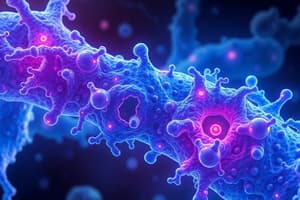Podcast
Questions and Answers
Which proteins are targeted for proteolytic digestion by the ubiquitin-proteasome pathway?
Which proteins are targeted for proteolytic digestion by the ubiquitin-proteasome pathway?
- Viral proteins only
- Phagocytosed microbes only
- Misfolded cytosolic and nuclear proteins only
- All of the above (correct)
What happens to unfolded proteins in the cell?
What happens to unfolded proteins in the cell?
- They are degraded into peptides by the proteasomes (correct)
- They are transported into the endoplasmic reticulum
- They are targeted for proteolytic digestion by the ubiquitin-proteasome pathway
- They are covalently tagged with ubiquitin
Which cells become very efficient at cleaving cytosolic and nuclear proteins into peptides?
Which cells become very efficient at cleaving cytosolic and nuclear proteins into peptides?
- All cells
- Infected cells
- Tumor cells
- Cells exposed to inflammatory cytokines (correct)
Which molecule is responsible for transporting proteasome-generated peptides into the ER?
Which molecule is responsible for transporting proteasome-generated peptides into the ER?
What is the function of tapasin in the peptide loading process?
What is the function of tapasin in the peptide loading process?
Why are empty class I MHC molecules eventually degraded in the ER?
Why are empty class I MHC molecules eventually degraded in the ER?
What happens when a class I MHC molecule binds tightly to a peptide generated from proteasomal digestion?
What happens when a class I MHC molecule binds tightly to a peptide generated from proteasomal digestion?




